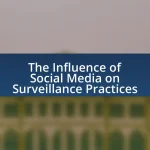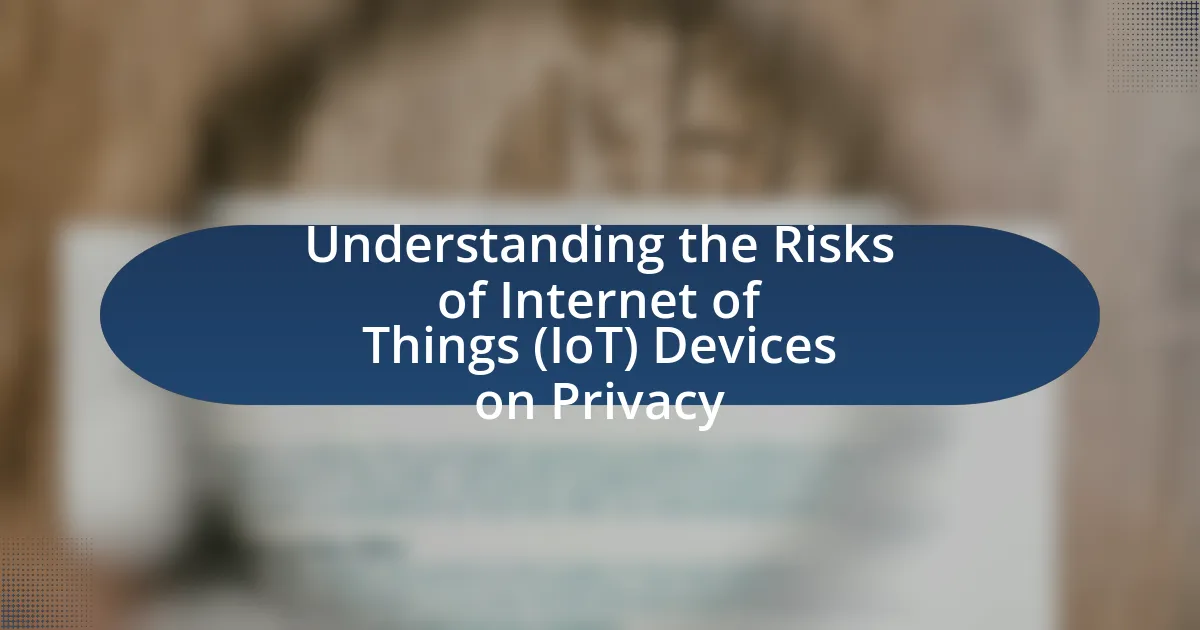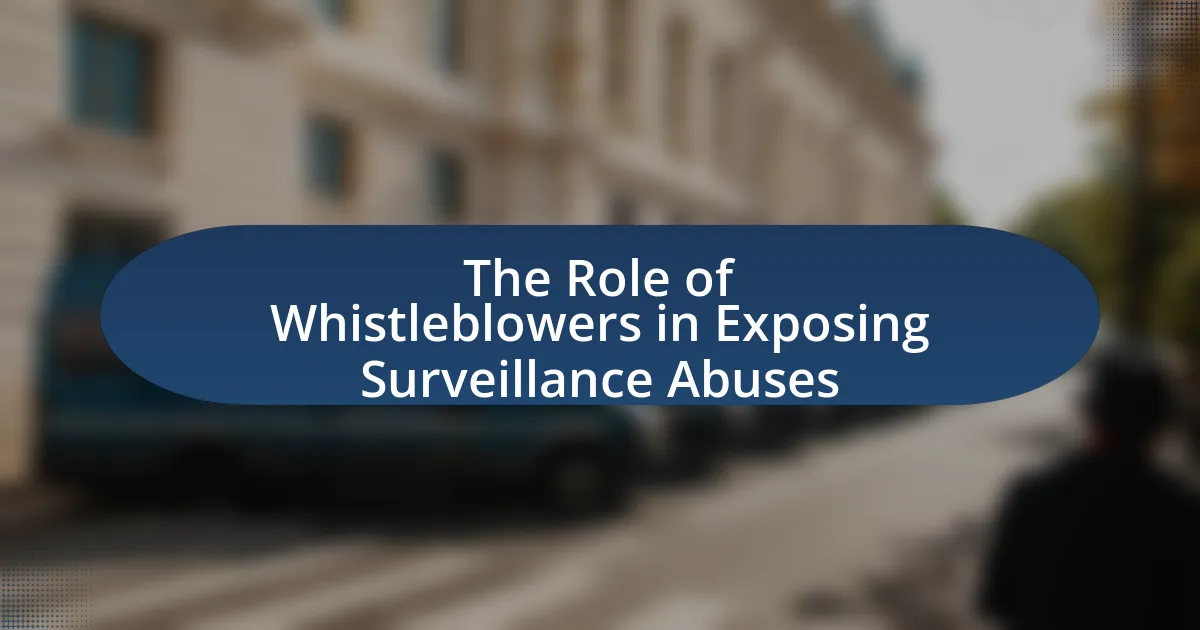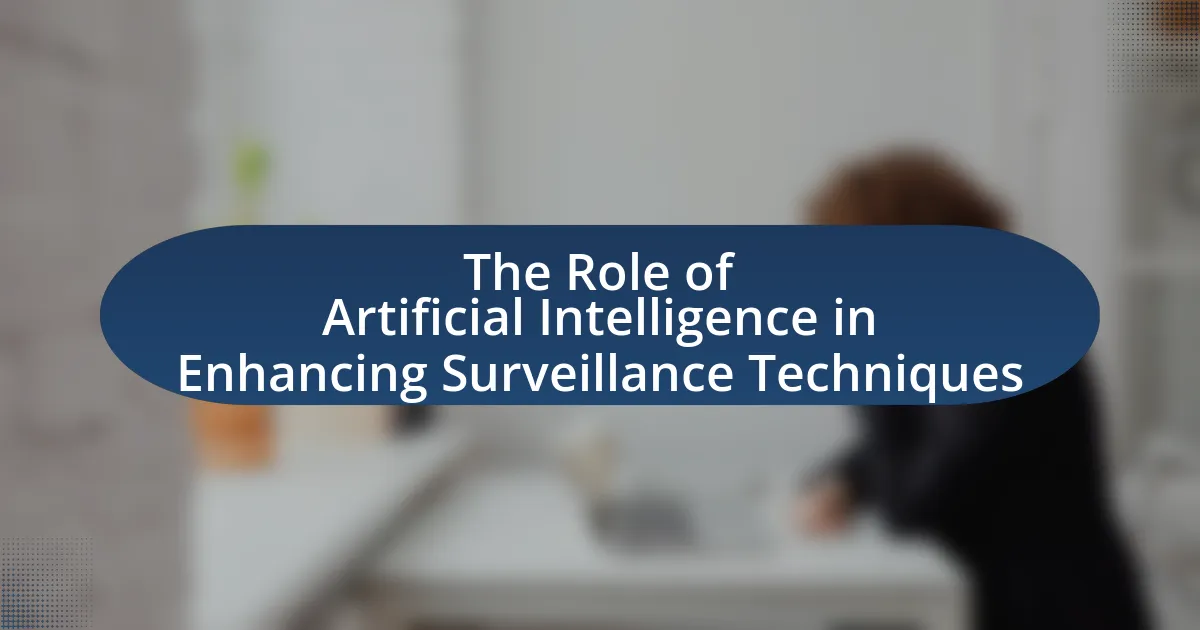Encryption is a vital technology for safeguarding data and communications against unauthorized surveillance. It operates by converting readable information into an unreadable format, ensuring that only authorized users with the correct decryption keys can access the original content. The article explores the mechanisms of encryption, including end-to-end encryption, symmetric and asymmetric encryption, and their roles in protecting privacy during digital communication. It also addresses the principles of encryption technology, the threats posed by surveillance, and the challenges and limitations associated with encryption, such as vulnerabilities and regulatory constraints. Additionally, the article discusses best practices for individuals to enhance their encryption usage and the implications of encryption in the context of privacy rights and security needs.
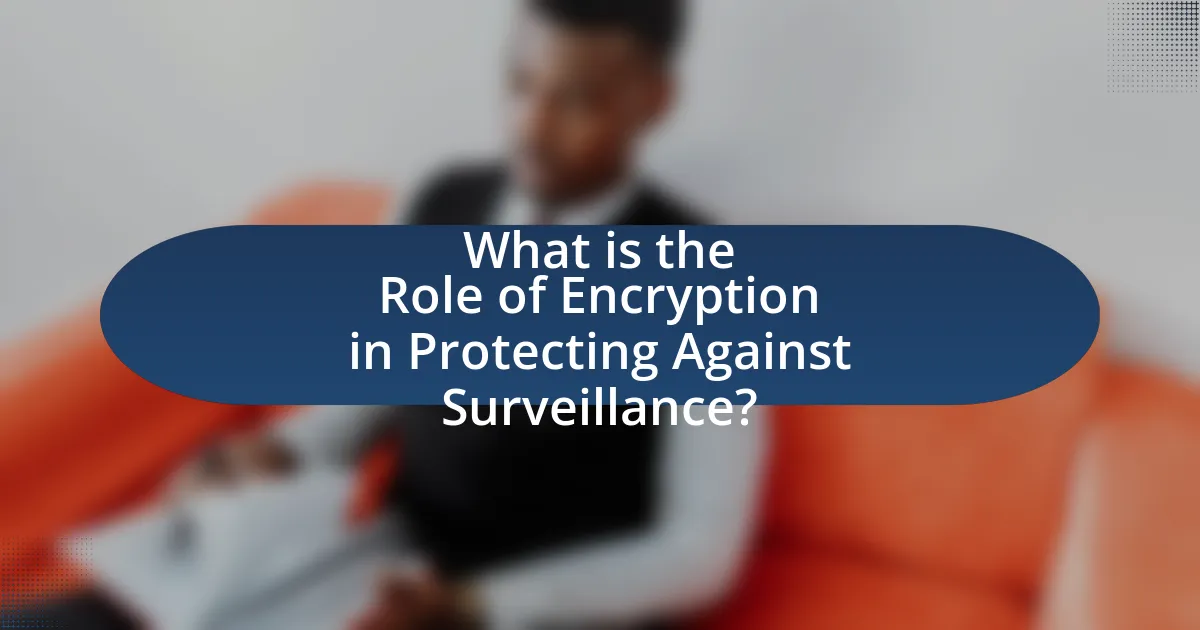
What is the Role of Encryption in Protecting Against Surveillance?
Encryption plays a crucial role in protecting against surveillance by securing data and communications from unauthorized access. It transforms readable information into an unreadable format, ensuring that only authorized parties with the correct decryption keys can access the original content. For instance, end-to-end encryption used in messaging applications like Signal and WhatsApp prevents third parties, including service providers and potential attackers, from intercepting and reading messages. According to a report by the Electronic Frontier Foundation, encryption significantly reduces the risk of data breaches and unauthorized surveillance, as it makes intercepted data useless without the decryption key.
How does encryption function as a protective measure against surveillance?
Encryption functions as a protective measure against surveillance by converting readable data into an unreadable format, ensuring that only authorized parties can access the original information. This process involves algorithms that scramble the data, making it incomprehensible to anyone who intercepts it without the correct decryption key. For instance, the Advanced Encryption Standard (AES) is widely used to secure sensitive information, and its strength lies in the complexity of the encryption keys, which can be 128, 192, or 256 bits long. This level of encryption significantly reduces the risk of unauthorized access, as brute-force attacks to decipher the data would require an impractical amount of time and computational resources.
What are the key principles of encryption technology?
The key principles of encryption technology include confidentiality, integrity, authentication, and non-repudiation. Confidentiality ensures that only authorized parties can access the information, typically achieved through algorithms that transform plaintext into ciphertext. Integrity guarantees that the data has not been altered during transmission, often verified using hash functions. Authentication verifies the identity of the parties involved in communication, commonly implemented through digital signatures. Non-repudiation prevents an entity from denying the authenticity of their signature on a document or a message, ensuring accountability. These principles are foundational to secure communications and are critical in protecting against unauthorized surveillance.
How does encryption secure data during transmission?
Encryption secures data during transmission by converting the information into a coded format that is unreadable to unauthorized users. This process involves algorithms that scramble the data, ensuring that only individuals with the correct decryption key can access the original content. For instance, protocols like TLS (Transport Layer Security) are widely used to encrypt data sent over the internet, protecting sensitive information such as passwords and credit card numbers from interception. Studies show that encrypted communications significantly reduce the risk of data breaches, as they make it exceedingly difficult for attackers to decipher the transmitted information without the appropriate keys.
Why is encryption essential in the context of privacy and surveillance?
Encryption is essential in the context of privacy and surveillance because it protects sensitive information from unauthorized access. By converting data into a coded format, encryption ensures that only authorized parties can read or interpret the information, thereby safeguarding personal communications and sensitive data from government and corporate surveillance. For instance, the use of end-to-end encryption in messaging apps like Signal and WhatsApp prevents third parties from intercepting and accessing the content of messages, which is crucial in maintaining user privacy. According to a 2020 report by the Electronic Frontier Foundation, encryption is a fundamental tool for protecting civil liberties and ensuring that individuals can communicate freely without fear of being monitored.
What threats does surveillance pose to individual privacy?
Surveillance poses significant threats to individual privacy by enabling the collection and analysis of personal data without consent. This intrusion can lead to unauthorized access to sensitive information, resulting in identity theft, discrimination, and loss of autonomy. For instance, a report by the Electronic Frontier Foundation highlights that government surveillance programs can track individuals’ online activities, compromising their ability to communicate freely and securely. Furthermore, studies indicate that pervasive surveillance can create a chilling effect, discouraging individuals from expressing themselves or engaging in dissenting activities due to fear of being monitored.
How does encryption mitigate these threats?
Encryption mitigates threats by transforming readable data into an unreadable format, ensuring that only authorized parties can access the original information. This process protects sensitive communications from unauthorized interception and surveillance, as even if data is captured, it remains unintelligible without the decryption key. For instance, the use of Advanced Encryption Standard (AES) has been widely adopted, providing a robust level of security that is difficult to break, thereby safeguarding personal and organizational data against eavesdropping and data breaches.
What types of encryption are commonly used for protection against surveillance?
Commonly used types of encryption for protection against surveillance include end-to-end encryption, symmetric encryption, and asymmetric encryption. End-to-end encryption ensures that only the communicating users can read the messages, preventing unauthorized access during transmission. Symmetric encryption uses the same key for both encryption and decryption, making it efficient for securing data at rest and in transit. Asymmetric encryption employs a pair of keys—public and private—allowing secure key exchange and authentication, which is crucial for establishing secure connections over the internet. These encryption methods are widely adopted in applications like messaging services, email, and secure file storage to safeguard user privacy against surveillance threats.
What is symmetric encryption and how does it work?
Symmetric encryption is a cryptographic method where the same key is used for both encryption and decryption of data. In this process, a plaintext message is transformed into ciphertext using a secret key, and the same key is required to revert the ciphertext back to its original plaintext form. This method relies on the confidentiality of the key; if the key remains secure, the encrypted data is protected from unauthorized access. Symmetric encryption algorithms, such as AES (Advanced Encryption Standard), are widely used due to their efficiency and speed in encrypting large amounts of data, making them suitable for various applications, including secure communications and data storage.
What is asymmetric encryption and what are its advantages?
Asymmetric encryption is a cryptographic method that uses a pair of keys: a public key for encryption and a private key for decryption. This dual-key system enhances security by allowing users to share their public key openly while keeping the private key confidential. The advantages of asymmetric encryption include improved security, as the private key is never shared, and the ability to facilitate secure communications and digital signatures, which verify the authenticity of messages. For instance, the use of asymmetric encryption in protocols like SSL/TLS ensures secure online transactions, protecting sensitive data from unauthorized access.
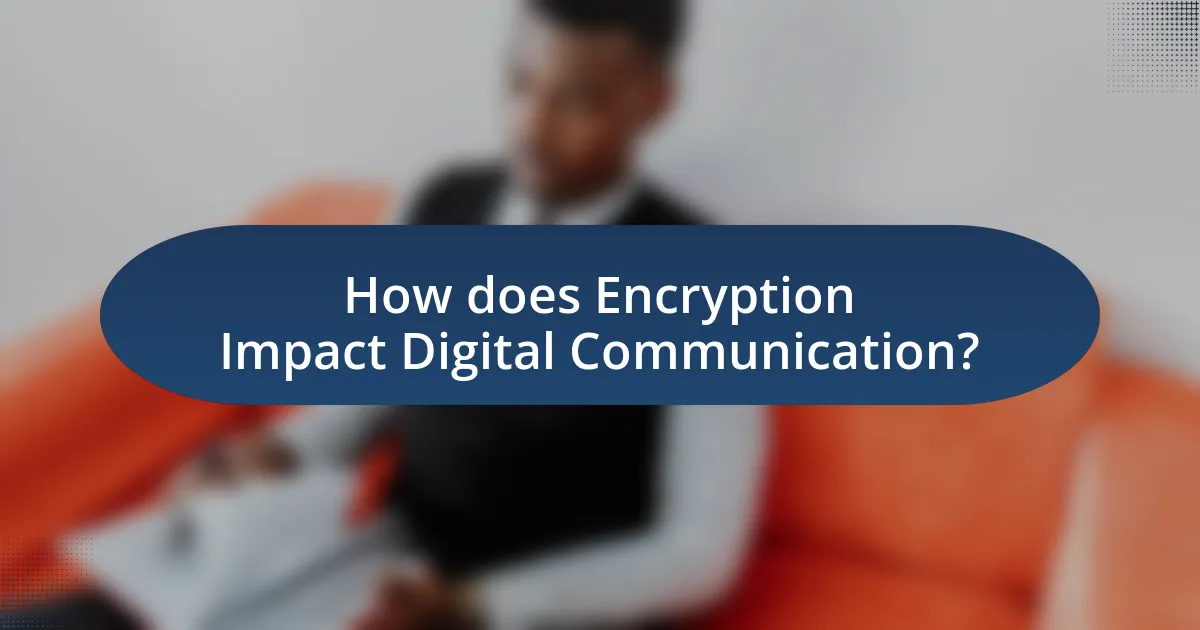
How does Encryption Impact Digital Communication?
Encryption significantly enhances the security and privacy of digital communication by converting information into a coded format that is unreadable to unauthorized users. This process ensures that sensitive data, such as personal messages and financial transactions, remains confidential during transmission over the internet. For instance, the use of end-to-end encryption in messaging applications like WhatsApp prevents third parties from accessing the content of conversations, thereby protecting users from potential surveillance and data breaches. According to a report by the Electronic Frontier Foundation, encryption is a critical tool in safeguarding personal privacy and maintaining the integrity of communications in an increasingly monitored digital landscape.
What role does encryption play in securing online communications?
Encryption plays a critical role in securing online communications by converting data into a coded format that can only be read by authorized parties. This process ensures that sensitive information, such as personal messages and financial transactions, remains confidential and protected from unauthorized access. For instance, end-to-end encryption used in messaging applications like Signal and WhatsApp prevents third parties, including service providers and hackers, from intercepting and deciphering the content of communications. According to a report by the Electronic Frontier Foundation, encryption is essential for safeguarding privacy and maintaining the integrity of data transmitted over the internet, thereby significantly reducing the risk of surveillance and data breaches.
How does end-to-end encryption enhance privacy in messaging apps?
End-to-end encryption enhances privacy in messaging apps by ensuring that only the communicating users can read the messages, preventing unauthorized access from third parties, including service providers. This encryption method secures messages by encrypting them on the sender’s device and only decrypting them on the recipient’s device, meaning that even if data is intercepted during transmission, it remains unreadable without the decryption key. According to a report by the Electronic Frontier Foundation, end-to-end encryption significantly reduces the risk of surveillance and data breaches, as it limits the ability of hackers and government entities to access private conversations.
What are the implications of encryption for email security?
Encryption significantly enhances email security by ensuring that only authorized parties can access the content of messages. This process protects sensitive information from unauthorized interception, making it difficult for hackers and surveillance entities to read or manipulate the data. According to a 2020 report by the Electronic Frontier Foundation, encrypted emails can reduce the risk of data breaches and maintain user privacy, as encryption protocols like PGP (Pretty Good Privacy) and S/MIME (Secure/Multipurpose Internet Mail Extensions) provide robust security measures. These protocols encrypt the email content and attachments, ensuring that even if the data is intercepted, it remains unreadable without the proper decryption keys.
How do different platforms implement encryption for user protection?
Different platforms implement encryption for user protection through various methods, including end-to-end encryption, transport layer security, and data-at-rest encryption. For instance, messaging apps like WhatsApp and Signal utilize end-to-end encryption, ensuring that only the communicating users can read the messages, as the encryption keys are stored solely on their devices. In contrast, platforms like Facebook use transport layer security (TLS) to encrypt data in transit, protecting it from interception during transmission. Additionally, cloud storage services such as Google Drive employ data-at-rest encryption, safeguarding stored files from unauthorized access by encrypting them while they are stored on servers. These implementations are crucial for maintaining user privacy and security against potential surveillance threats.
What are the encryption standards used by major social media platforms?
Major social media platforms utilize various encryption standards to protect user data. Facebook employs end-to-end encryption for its Messenger service, using the Signal Protocol, which ensures that only the communicating users can read the messages. WhatsApp, owned by Facebook, also uses end-to-end encryption based on the Signal Protocol, providing similar security for its messaging service. Twitter uses TLS (Transport Layer Security) to encrypt data in transit, ensuring secure connections between users and its servers. Instagram, another Facebook subsidiary, implements end-to-end encryption for direct messages, similar to WhatsApp. Snapchat employs end-to-end encryption for messages and snaps, ensuring that only the sender and recipient can access the content. These encryption standards are crucial in safeguarding user privacy and protecting against unauthorized surveillance.
How do businesses utilize encryption to protect customer data?
Businesses utilize encryption to protect customer data by converting sensitive information into a coded format that can only be accessed by authorized parties. This process ensures that even if data is intercepted during transmission or accessed without permission, it remains unreadable and secure. For instance, many companies implement end-to-end encryption in their communication platforms, which means that only the sender and the intended recipient can read the messages, effectively safeguarding personal information from unauthorized access. Additionally, according to a 2021 report by the Ponemon Institute, organizations that employ encryption experience 50% fewer data breaches compared to those that do not, highlighting the effectiveness of encryption in enhancing data security.
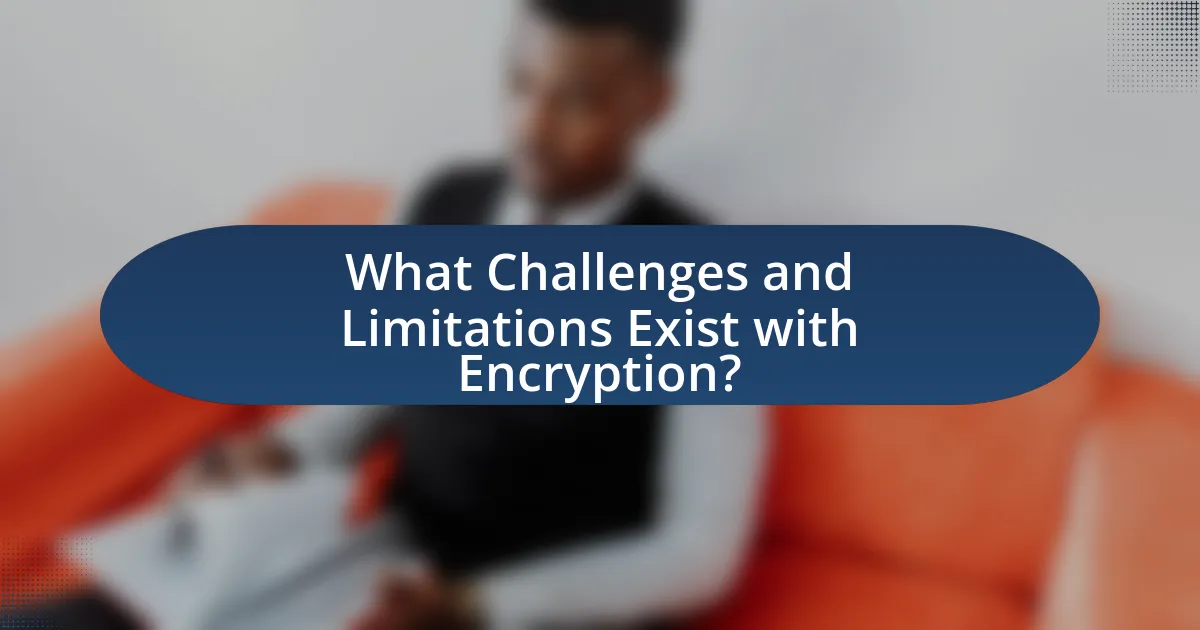
What Challenges and Limitations Exist with Encryption?
Encryption faces several challenges and limitations, primarily including vulnerability to attacks, key management issues, and regulatory constraints. Vulnerabilities arise from potential exploits in encryption algorithms, as evidenced by the 2017 discovery of weaknesses in the RSA algorithm, which can compromise data security. Key management issues complicate the secure storage and distribution of encryption keys, leading to risks of unauthorized access; a 2020 study highlighted that 70% of organizations struggle with key management. Additionally, regulatory constraints, such as the requirements for backdoors in encryption by governments, can undermine the effectiveness of encryption, as seen in debates surrounding the USA’s proposed legislation on encryption backdoors. These factors collectively hinder the reliability and effectiveness of encryption in protecting against surveillance.
What are the potential vulnerabilities associated with encryption?
Encryption can have several potential vulnerabilities, including weak algorithms, implementation flaws, and key management issues. Weak algorithms, such as those that are outdated or poorly designed, can be susceptible to attacks, allowing unauthorized access to encrypted data. Implementation flaws arise when encryption is not correctly applied, leading to potential leaks or exposure of sensitive information. Key management issues, including poor storage or sharing practices, can result in keys being compromised, rendering the encryption ineffective. These vulnerabilities highlight the importance of using strong, well-reviewed encryption methods and maintaining robust key management practices to ensure data security.
How can weak encryption algorithms be exploited by attackers?
Weak encryption algorithms can be exploited by attackers through various methods, including brute force attacks, cryptanalysis, and man-in-the-middle attacks. Brute force attacks involve systematically trying all possible keys until the correct one is found, which is feasible with weak algorithms due to their limited key space. For instance, the Data Encryption Standard (DES), which has a key length of only 56 bits, can be cracked in a matter of hours using modern computing power. Cryptanalysis techniques can also reveal vulnerabilities in weak algorithms, allowing attackers to decipher encrypted data without needing the key. Additionally, man-in-the-middle attacks can occur when weak encryption fails to authenticate the communicating parties, enabling attackers to intercept and manipulate data. These exploitation methods highlight the critical need for strong encryption standards to safeguard against unauthorized access and data breaches.
What role do human factors play in the effectiveness of encryption?
Human factors significantly influence the effectiveness of encryption by determining how securely individuals implement and manage encryption technologies. For instance, user behavior, such as the choice of weak passwords or failure to update encryption protocols, can compromise the intended security benefits of encryption. Research indicates that human error accounts for approximately 95% of cybersecurity breaches, highlighting the critical role of user awareness and training in maintaining encryption integrity. Therefore, even the most robust encryption systems can be rendered ineffective if users do not adhere to best practices in their application and management.
How do governments and organizations respond to encryption in surveillance efforts?
Governments and organizations respond to encryption in surveillance efforts by implementing legal frameworks and technological measures to access encrypted communications. For instance, many governments advocate for “backdoor” access to encryption systems, arguing that it is necessary for national security and law enforcement. In the United States, the FBI has frequently called for legislation that would require tech companies to provide law enforcement with access to encrypted data, citing cases where encryption has hindered criminal investigations. Additionally, organizations may develop advanced surveillance technologies that can bypass encryption, such as exploiting vulnerabilities in software or using metadata analysis to gather information without decrypting the content. These responses reflect a tension between privacy rights and security needs, as seen in debates surrounding the USA PATRIOT Act and similar legislation in other countries.
What are the arguments for and against backdoor access to encrypted data?
Arguments for backdoor access to encrypted data include enhanced law enforcement capabilities, as it allows authorities to access critical information during investigations, potentially preventing crimes and terrorism. For instance, the FBI has argued that backdoors can help in cases where encrypted communications hinder investigations, citing instances where access to data could have led to timely interventions.
Arguments against backdoor access emphasize the risks to user privacy and security, as creating a backdoor inherently weakens encryption, making it vulnerable to exploitation by malicious actors. Experts warn that once a backdoor exists, it can be discovered and misused, leading to breaches of sensitive information. The Electronic Frontier Foundation highlights that backdoors can undermine trust in digital communications, as users may fear surveillance and data theft.
How do legal frameworks impact the use of encryption technologies?
Legal frameworks significantly influence the use of encryption technologies by establishing regulations that either promote or restrict their deployment. For instance, laws such as the General Data Protection Regulation (GDPR) in Europe encourage the use of encryption to protect personal data, thereby fostering its adoption among businesses. Conversely, some jurisdictions impose restrictions on strong encryption, requiring backdoors for law enforcement access, which can undermine the effectiveness of encryption and deter its use. The balance between privacy rights and security needs is often reflected in these legal frameworks, shaping how encryption technologies are developed and implemented in various regions.
What best practices can individuals follow to enhance their encryption usage?
Individuals can enhance their encryption usage by employing strong, unique passwords for each encrypted account and utilizing two-factor authentication. Strong passwords should be at least 12 characters long, combining letters, numbers, and symbols, which significantly reduces the risk of unauthorized access. Two-factor authentication adds an additional layer of security by requiring a second form of verification, such as a text message or authentication app, making it harder for attackers to gain access even if they have the password. Furthermore, individuals should regularly update their encryption software to protect against vulnerabilities, as outdated software can be exploited by attackers. Using end-to-end encryption for communications, such as messaging apps that offer this feature, ensures that only the intended recipients can read the messages, thereby safeguarding privacy against potential surveillance.
How can users choose the right encryption tools for their needs?
Users can choose the right encryption tools for their needs by assessing their specific security requirements, understanding the types of data they need to protect, and evaluating the features of available tools. For instance, users should consider whether they require end-to-end encryption for messaging, file encryption for sensitive documents, or full disk encryption for entire devices. Additionally, users should research the reputation and security protocols of encryption tools, as well as their compliance with industry standards, such as AES-256 encryption, which is widely recognized for its strength. According to a report by the Electronic Frontier Foundation, tools that prioritize user privacy and have undergone independent security audits are generally more reliable.
What steps can individuals take to ensure their encrypted communications remain secure?
Individuals can ensure their encrypted communications remain secure by using strong, up-to-date encryption protocols and regularly updating their software. Utilizing end-to-end encryption services, such as Signal or WhatsApp, protects messages from interception. Additionally, individuals should enable two-factor authentication to add an extra layer of security. Regularly reviewing privacy settings and being cautious about sharing sensitive information online further enhances security. According to a 2021 report by the Electronic Frontier Foundation, using strong encryption significantly reduces the risk of unauthorized access to communications, highlighting the importance of these steps.

